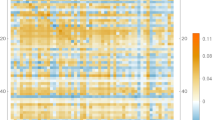Abstract
The aim of the paper is to examine the effects on employment of the large-scale structural adjustment programme undertaken by Turkey from the early 1980s onwards. In this respect, we particularly analyse how appropriate the choices of factor intensity after structural adjustment programme have been in the domestic production in comparison with the availability of domestic factor endowment. Our findings show that foreign trade in intermediate goods creates extra use of domestic labour, which can be considered as the labour cost of importing intermediate goods. This is the case in the majority of industries in the pre- and post-liberalisation period in Turkey. However, the capacity of using extra labour as a result of importing intermediate goods appeared to have decreased in the post-liberalisation period.
Similar content being viewed by others
References
Addison, T. & Demery, L. (1993). Labour markets, poverty and adjustment. Journal of International Development, 5(2), 135–143.
Alauddin, M. & Tisdell, C. (1988). The use of input-output analysis to determine the appropriateness of technology and industries: Evidence from Bangladesh. Economic Development and Cultural Change, 36(2): 369–391. Arıcanlı, T. & Rodrik, D. (1990). The Political Economy of Turkey: Debt, Adjustment and Sustainability, London: MacMillan Press.
Baysan, T. & Blitzer, C. (1990). Turkey's trade liberalisation in the 1980s and prospects for its sustainability. In T. Arıcanlı & D. Rodrik (Eds.), The Political Economy of Turkey: Debt, Adjustment, and Sustainability, pp. 9–36.
Bilginsoy, C. (1993). Inflation, growth, and import bottlenecks in the Turkish manufacturing industry. Journal of Development Economics, 42, 111–131.
Bulmer-Thomas, V. (1982). Input-Output Analysis in Developing Countries. New York: Wiley.
Bulutay, T. (1995). Employment, Unemployment and Wages in Turkey. Ankara: State Institute of Statistics and International Labour Organisation.
Celasun, M. (1989). Income distribution and employment aspects of Turkey's post 1980 adjustment. METU Studies on Development, 16(3-4), 1–31.
Celasun, M. & Rodrik, D. (1989). Debt, adjustment and growth: Turkey. In J.D. Sachs & S.M. Collins (Eds.), Developing Country Debt and Economic Performance: Country Studies-Indonesia, Korea, Philippines, Turkey. Chicago: The University of Chicago Press.
Günlük-Şenesen, G. (1998). An input-output analysis of employment structure in Turkey: 1973-1990. Economic Research Forum Conference for Arab Countries, Iran and Turkey Working Paper 9809, Cairo.
Günçavdı, Ö. & Küçükçifçi, S. (2004). Observations on the employment generation capacity of the Turkish economy. Economics, Business and Finance Journal, No. 216, pp. 16–39. (in Turkish).
Günlük-Şenesen, G. & Kü ç ü kçifçi, S. (1994). Decomposition of structural change into technology and price components: Turkey, 1973/1985. Economic Systems Research, 6(2), 199-215.
glu, A., Erçevik, A.S. & Tercan, P. (2002). Labour Market and Unemployment in Turkey, TÜSİAD Publication, No. TÜSİAD-T/2002/12-354, Istanbul (in Turkish).
Hashim, S.R. (1996). {Growth, technology and employment}, In R.K. Koti et al. (Ed.), Studies in Indian Economy, pp. 167–195.
Horton, S., Kanbur, R. & Mazumdar, D. (1991). Labour markets in an era of adjustment-evidence from 12 developing countries, International Labour Review, 130 (5–6).
Horton, S., Kanbur, R. & Mazumdar, D., (Eds.) (1994). Labour Markets in an Era of Adjustment, two volumes. Washington DC: World Bank.
Koti, R.K., Venkatramaiah, P., Radhakrishna, R. & Hashim, S.R. (1996). Studies in Indian Economy. Bombay: Himalaya Publishing House.
Köse, H. A. & Yeldan, E. (1996). Türkiye Ekonomisinde Sektörel IŞgücü İstihdamı ve Ücret Yapısı Üzerine Bir Deneme (On Sectoral Employment and Wage Structure in the Turkish Economy). Mimo., Bilkent University, Department of Economics, Ankara.
Nas, T. & Odekon, M. (1992), Economics and Politics of Turkish Liberalisation, Bethlehem: Leigh University Press.
Olgun, H. & Togan, S. (1990). Trade liberalisation and the structure of protection in Turkey in the 1980's: A quantitative analysis, Weltwirtschaftliches Archiv 127(1): 152–169.
Özar, Ş. (1995). The Informal Sector in Turkey, paper presented at ERF Conference, December 1-3, Aswan, Egypt.
Riedel, J. (1975). Factor proportions, linkages, and the open developing economy. Review of Economic and Statistics, 57(4), 487–494; also In I. Sohn (Ed.), pp. 340-349.
Rodrik, D. (1991). Premature liberalisation, incomplete stabilisation: The Özal decade in Turkey, In M. Buruno, S. Fischer, E. Helpman & N. Liviatan with L.R. Meridor (Eds.), Lessons of Economic Stabilisation and Its Aftermath. Cambridge, MA: The MIT Press.
Sarma, A. & Ram, K. (1989). Income, output and employment linkages and import intensities of manufacturing industries in India, Journal of Development Studies 25(2), 192–209.
SIS (1996a). The Input-Output Structure of the Turkish Economy in 1990. Ankara: State Institute of Statistics.
SIS (1996b). Statistical Indicators (1923-1995). Ankara: State Institute of Statistics.
SIS (1973). The Input-Output of the Turkish Economy, Ankara: State Institute of Statistics (in Turkish).
330 SIS (1990). The Input-Output of the Turkish Economy, Ankara: State Institute of Statistics (in Turkish).
Sohn, I. (1995). Readings in Input-Output Analysis. New York: Oxford University Press.
SPO (1997). Economic and Social Indicators (1950-1997). Ankara: State Planning Organisation.
Stone, R. & Brown, J.A.C. (1965). Exploring 1970: Some Numerical Results, Vol: 6 in A Programme for Growth, Department of Applied Economics and Chapman and Hall, June.
Toye, J. (1995). Structural Adjustment and Employment Policy: Issues and Experience. Geneva: International Labour Office.
Yeldan. E. (2000). The impact of financial liberalisation and the rise of financial rents on income inequality: The case of Turkey. Working Papers No. 206, The United Nations University, World Institute for Development Economics Research (WIDER), November.
Wood, A. (1994), North-South Trade, Employment and Inequality. Oxford: Clarendon Press. 331
Author information
Authors and Affiliations
Rights and permissions
About this article
Cite this article
Günçavdi, Ö., KüçükçifçI, S. & McKay, A. Adjustment, Stabilisation and the Analysis of the Employment Structure in Turkey: An Input- Output Approach. Economics of Planning 36, 315–331 (2003). https://doi.org/10.1023/B:ECOP.0000038300.31498.7f
Issue Date:
DOI: https://doi.org/10.1023/B:ECOP.0000038300.31498.7f




